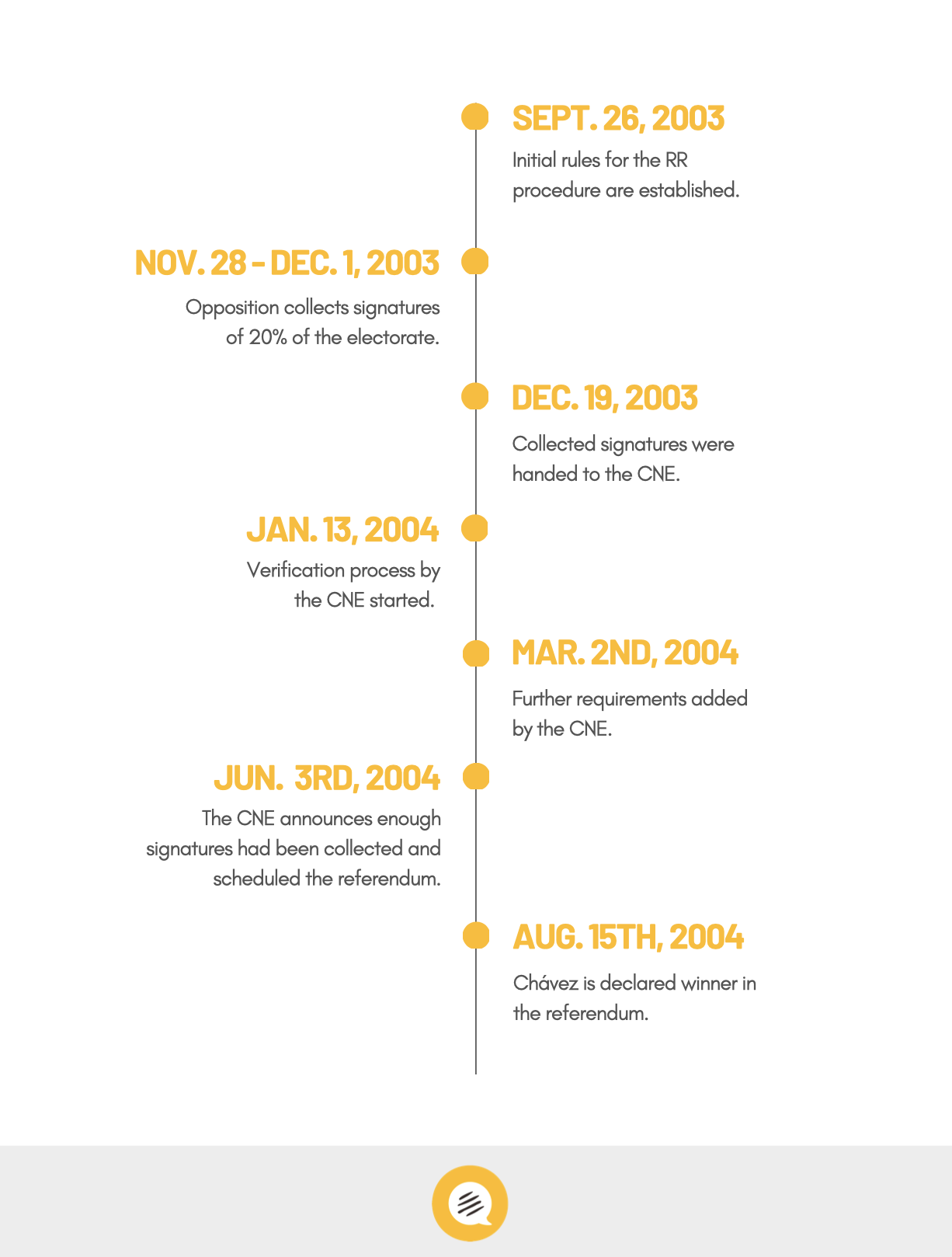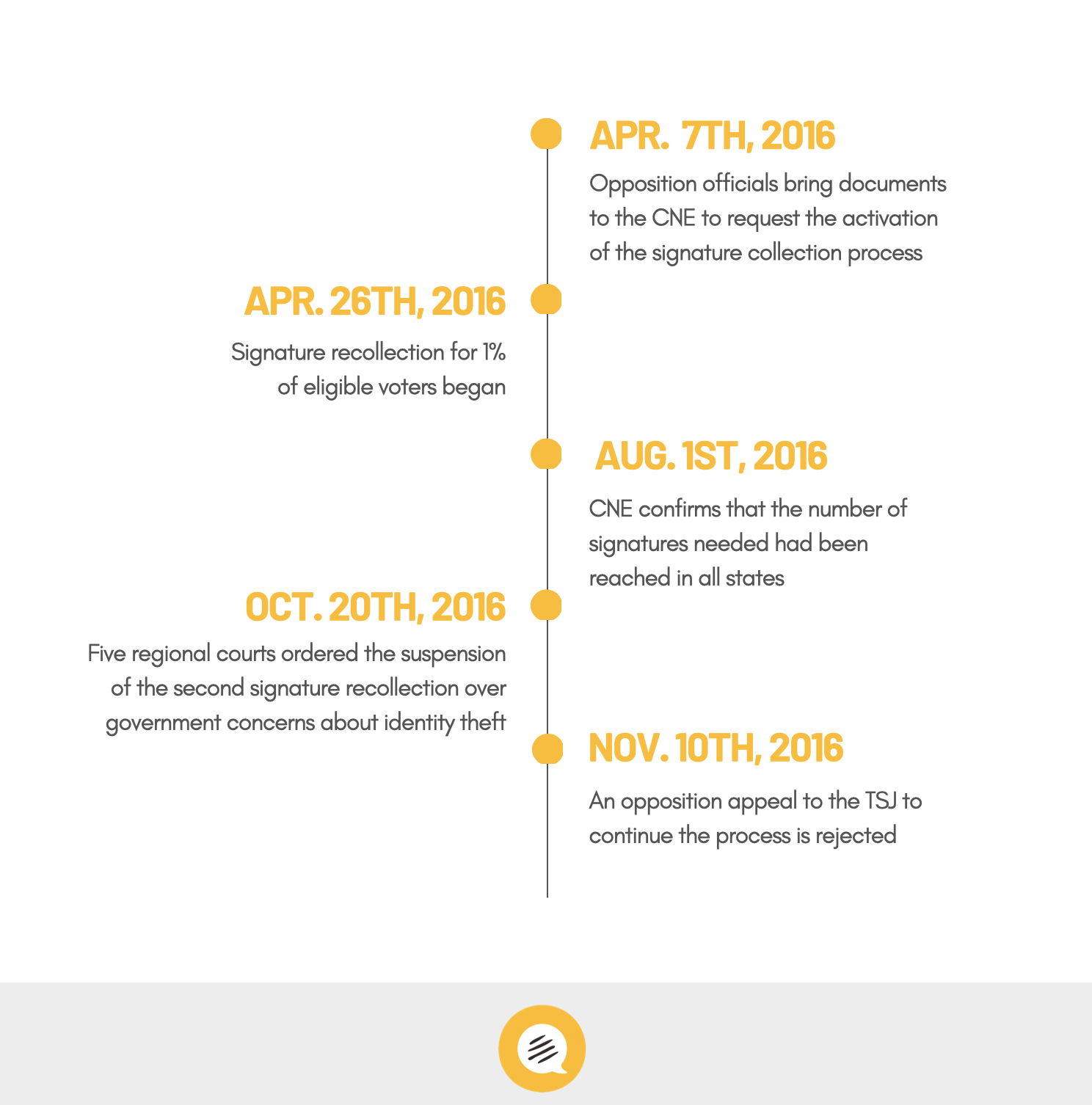The Sloppy History of the Recall Referendum in Venezuela
Now that a part of the opposition is attempting a doomed to fail recall referendum to remove Maduro from the presidency, we look at the history of how chavismo weaponized a tool they included in the Constitution that was supposed to expand democratic rights


Photo: Getty Images
Over the last few days, the idea of a recall referendum (RR) against Nicolás Maduro has become the subject of much of the Venezuelan political discourse. The National Electoral Council (CNE) approved three initial requests for a recall referendum pushed by small opposition factions last week, most notably MOVER, led by Nicmer Evans and César Pérez Vivas. This move was followed by the announcement of a signature collection timeframe scheduled for January 26th, that has been heavily criticized and considered impossible to achieve as it would require collecting the signatures of 20% of the voting population in just one day.
The recall referendum has been one of the recurrent characters in the political conflict between chavismo and opposition and it has only yielded bad results for the opposition throughout its complicated history. However, proponents see it as an avenue to take advantage of the opposition’s electoral success in the Barinas gubernatorial election. Therefore, as we pay attention to the outcome of this unlikely referendum initiative, I think it’s a good idea to revisit the complex process behind the RR and its role in recent Venezuelan history.
The Process
According to Article 72 of the 1999 Constitution, any government position that is elected with the popular vote can be subject to revocation via recall referendum. This process operates as a popular election where, if the official in question loses, he or she is removed from office. In theory, it doesn’t seem very complicated. However, getting to the point of holding the election is a complex multi-step process that is worth revisiting.
- The process can be activated after one half of an official’s term in office has elapsed.
- The CNE has to set up a schedule for the requesting party to collect signatures of 1% of the voting population, which then need to be confirmed by citizens in CNE designated machines and validated by said organization.
- Once the initial round of signatures is collected and approved, the CNE sets up a schedule for the collection of signatures of 20% of the voting population corresponding to the official in question.
- After those signatures are collected, verified, and validated, a recall referendum election is scheduled. The officer being recalled is removed only if 25% of the eligible voters participate and the number of voters supporting the removal of the official exceeds the number of people that originally voted for them.
If the president is removed during the first four years of their term, per article 233 of the Constitution, then a new presidential election is held. But any time after that, the Vice President finishes the removed president’s term. With that established, let’s review the previous attempts of making this process happen in contemporary history.
2004: A Chaotic First Attempt 
The first attempt at a recall referendum happened in 2004. After the 2002 political crisis and subsequent oil strikes, the opposition mobilized in favor of activating a recall referendum against President Hugo Chávez as soon as it was allowed in the Constitution. However, the process of activating it was nothing less than an uphill climb. While there are some guidelines in the constitution, there wasn’t a clear legal framework at the time to run the procedure. The CNE decided most of the rules governing the process ad hoc and making the activation as difficult as possible.
The rules added included incredibly specific requirements on the time and location of the signature collection and even the forms voters had to sign. After an initial collection of 3.4 million signatures, significantly more than the 2.4 million needed, the process was rejected by the CNE, led by Jorge Rodriguez at the time. The CNE argued that only 1.8 million were valid. In addition, CNE also added the requirement that the information about those petitioning for the recall needed to be handwritten by the petitioners themselves, sending 1.1 million through a lengthy revision process that concluded in June 2004 with the announcement that enough signatures were collected and the RR could move forward.
The date for the referendum was set for August 15th, 2004. It is worth noting that, per Chávez’s request, the list of names of those who signed in favor of the referendum was sent to chavista deputy Luis Tascón and was leaked on his website, which led to a significant amount of persecution of opposition members. Thousands were fired from the public administration and their access to government programs and jobs was conditioned to having appeared on the Tascón List or not.
Interestingly enough, last Monday, PSUV president Diosdado Cabello said that, just like Chávez in the 2004 referendum, Maduro had the right to know who signed to activate the referendum against him, harkening back to the Tascón List and the persecutions that it caused.
After the vote, Chávez was declared the winner with 59% of support and 70% turnout, hence staying in office. It is plausible to believe that the start of the misiones, Chávez’s signature social programs, allowed him to win. Chávez’s support was severely affected by the 2002 crisis. The multiple delays in the procedure allowed for the launch and solidification of these social programs, which were able to recover and mobilize chavista support. However, while international observers said the election was fair, opposition leaders and multiple scholars have questioned the veracity of the result, including Ricardo Haussmann and Roberto Rigobon.
An important detail: the recall referendum has worked, but not at the presidential level. On October 7th, 2007, ten recall referendums took place in Venezuela, and four mayors and a regional lawmaker—two of them members of opposition parties—lost their seats.
2016: CNE Delays and Hurdles in the Courts
In 2016, the opposition-led National Assembly decided to move forward with a recall referendum against Nicolás Maduro, after months of discussion about a constitutional route to force a change in government. This was accelerated after government authorities started to limit the powers of the National Assembly. The recall effort was pushed by Henrique Capriles. The initial paperwork was submitted in April 2016, and after multiple delays, rejections, and emerging protests, the process of collection of 1% of voters was allowed to start at the end of April. This was a new step added in 2007.
Delays were an important topic throughout this referendum attempt, since the deadline that would allow the Vice President to finish the term should the president be removed was quickly approaching. The opposition submitted over six times the amount of signatures needed on May 2nd. Concerns were raised, however, that even if the opposition submitted the 1% of signatures of all eligible voters, the process could still be invalidated.
After much scrutiny by government authorities, the CNE announced that the initial signature requirements were fulfilled in each state by August 1st and the opposition could move forward with the collection of 20% of the signatures. However, by November, while the collection of 20% of the electorate was underway, five regional courts halted the second collection and invalidated the first after accusations of identity theft made by government officials. An opposition appeal to the TSJ was rejected, thus ending the recall referendum attempt and fueling the tension that would lead to the brutal 2017 protests.
2022: Would It Be Any Different This Time?
What should we expect from this process? Very little. There are no signs that this attempt of a recall referendum would be any different than previous attempts. I reached out to Dr. Guillermo Tell Aveledo, political science professor at the Metropolitan University in Caracas, and he pointed out some important patterns of the last two attempts that can give some insight: “There’s been a relative weakness in the opposition. Whenever the opposition has proposed the RR, the government is unpopular, but the lack of pressure and organization of the opposition makes it relatively weaker when confronting the State. So it doesn’t have anything else to turn towards. The RR acts like a Hail Mary to see if maybe it’s something that works.” He says that the first attempt came in the aftermath of the 2002 political crisis and how, despite the electoral successes of 2015 and the failure of La Salida protests in 2014 also led to the RR attempt in 2016.
According to Aveledo, the current situation is even more dire. “There isn’t a clear play for the opposition. There are currently no mobilizing events outside politics, it all hinges on the electoral calendar. So, there’s nothing else but to beg the government for the RR, which shows the relative weakness, the essential pattern of this situation.”
Aveledo further added that he has no expectations of this RR process. “I think that rather than being a mechanism to unite and mobilize, as it’s being presented by its proponents, it can further divide the opposition, posing an unclear dilemma about opposition leadership.” Political scientist Ana Milagros Parra agrees with the fact that there’s nothing to expect of the process. ”The CNE is basically rejecting the RR. The government saw that the opposition could mobilize and organize around the RR so they allowed the initial step to show the international community that there was a process, but up close, you can see that it’s impossible to implement.” She emphasized the difficult and heavily criticized signature collection process: “From 6:00 a.m, to 6:00 p.m., with so few centers, and knowing that 20% of each state’s voting population is needed, it’s just not possible.”
So, with a disjointed opposition, impossible signature collection and a deeply mistrusting electorate, the proposal for a referendum against Maduro is dead on arrival, shifting the spotlight into the opposition’s return to the negotiation table in Mexico and the upcoming 2024 presidential election, which is just around the corner.
Caracas Chronicles is 100% reader-supported.
We’ve been able to hang on for 22 years in one of the craziest media landscapes in the world. We’ve seen different media outlets in Venezuela (and abroad) closing shop, something we’re looking to avoid at all costs. Your collaboration goes a long way in helping us weather the storm.
Donate





